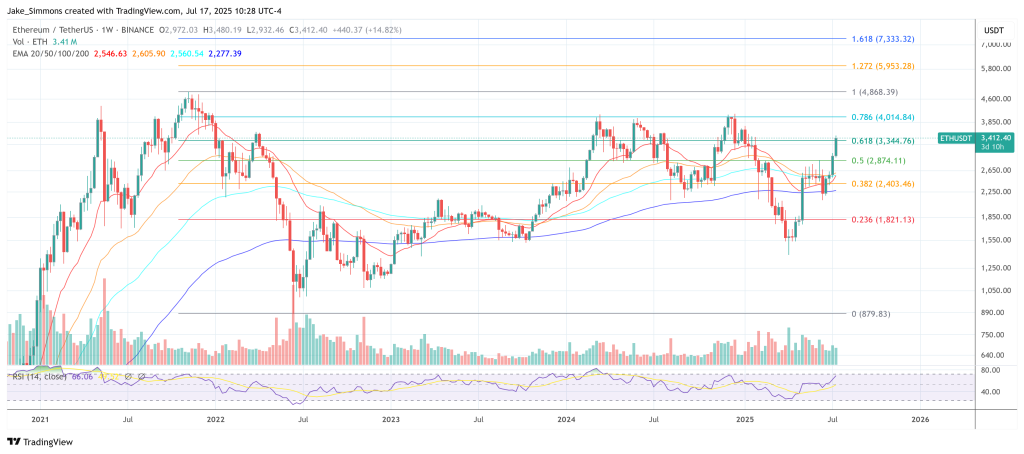Daniel Yan, the founder and Chief Investment Officer of Kryptanium Capital and a managing partner at Matrixport Ventures, with previous roles at Bitmain and Merrill Lynch, shared his thoughts today via X: “Many are likening SBET to MSTR and are therefore extremely bullish on both ETH and SBET. Alongside the substantial ETF inflows, this reasoning appears flawless… However, I believe SBET diverges significantly from MSTR in two key areas… All these factors indicate a peak in short-term interest.”
The ongoing comparison between SharpLink Gaming (SBET) and MicroStrategy (MSTR) has become a staple in crypto-equity discussions as Ether climbs to its highest point in 16 months, driven by unprecedented US spot-ETF investments. Yet, in a new post, venture capitalist Daniel Yan contends that these two “proxy” trades are less similar than the market perceives.
SharpLink Isn’t MicroStrategy—Implications for Ethereum’s Value
SharpLink’s rapid transformation from an i-gaming software provider to the largest corporate holder of Ether has been astonishing. Since declaring its treasury shift on June 2, the company has acquired 280,706 ETH (approximately $925 million) and staked almost all of it, earning 415 ETH as rewards. To support this acquisition, SharpLink raised $413 million by selling 24.6 million shares through an at-the-market (ATM) program from July 7 to July 11. The company still holds $257 million in authorized capital awaiting market deployment.
Management maintains that the dilution is balanced by increasing “ETH Concentration” (ETH divided by 1,000 assumed diluted shares), which rose from 2.00 to 2.46 ETH within five weeks. Nevertheless, Yan cautions that the very strategy enabling SharpLink’s accumulation—continuous equity issuance—also poses a risk: “This approach causes significant dilution to the ETH-per-share metric, making SBET more susceptible to negative market movements.”
MicroStrategy’s approach to Bitcoin is supported by inexpensive, long-term leverage. Since mid-2020, the company has issued $8.2 billion in convertible notes—all directed towards BTC—and has only occasionally used its own ATM facility. As converts come with an equity option, they dilute only if MSTR’s share price surges, aligning new issuance with positive market sentiment. Yan describes this as a “flywheel” that SBET lacks.
In fact, five of MicroStrategy’s six convertible issues are already significantly profitable as MSTR nears record highs, effectively converting the debt into quasi-equity under highly favorable terms. In contrast, SharpLink primarily relies on equity sales; each new tranche immediately increases the denominator, regardless of SBET’s trading status.
Yan also notes a governance imbalance: SharpLink was recapitalized by “one of the largest consortiums of ETH holders,” whose SBET shares vest in about five months. He suggests this setup as a “multi-party prisoner’s dilemma,” indicating insiders might be motivated to cash out quickly instead of managing a long-term treasury strategy.
MicroStrategy faces no similar unlocking event, as its executive chairman Michael Saylor holds the majority of the voting shares and has repeatedly vowed not to sell.
Yan’s insights come as Ethereum ETFs hit record highs. US-based spot funds absorbed $726.6 million in net inflows on Wednesday, marking their best day since inception and pushing total holdings over 5 million ETH. Optimists argue that such inflows will continue to support both Ether and any equity that holds it.
Even Yan admits “there is short-term merit in this.” But his analysis highlights that SharpLink’s model—prioritizing equity issuance before crypto acquisitions—comes with distinct risks compared to MicroStrategy’s debt-led approach. The main difference is straightforward: MicroStrategy’s converts dilute only if the investment is already succeeding; SharpLink’s ATM dilutes to enable the investment.
Yan is not predicting an immediate downturn—he specifically disclaims any short position in Ether—but he advises investors caught up in the “euphoric phase” to examine the capital-structure mechanics. If SharpLink’s insiders treat the company as a temporary vehicle and ETF momentum diminishes, the ATM-driven “flywheel” could reverse: more shares, reduced ETH-per-share, weaker SBET.
On the flip side, if Ether continues to rise and the company times its issuances well, shareholders might still experience MicroStrategy-style gains. The distinction, as Yan points out, is that SharpLink’s leverage is visible on the balance sheet, not concealed within a convertible note.
At the time of writing, ETH was trading at $3,412.











